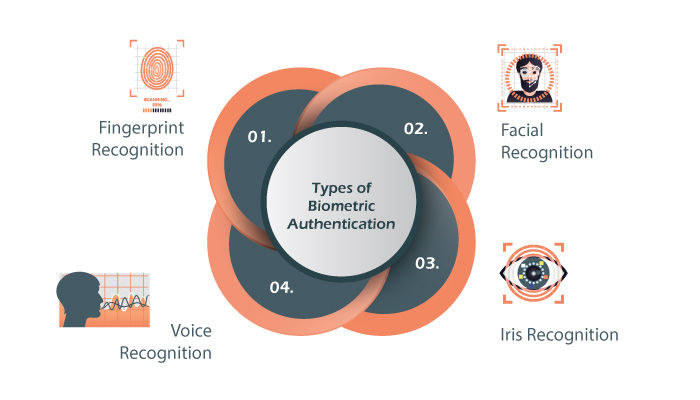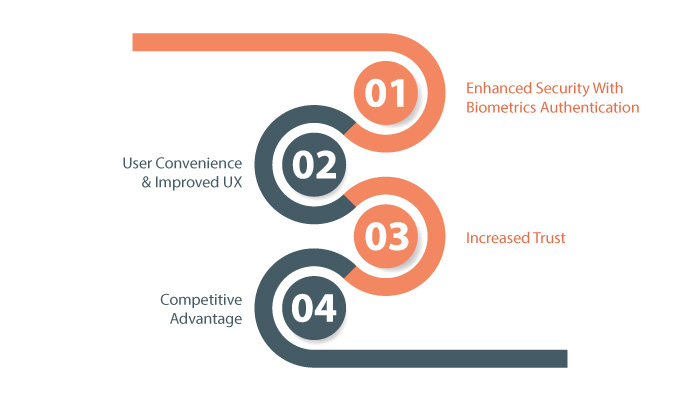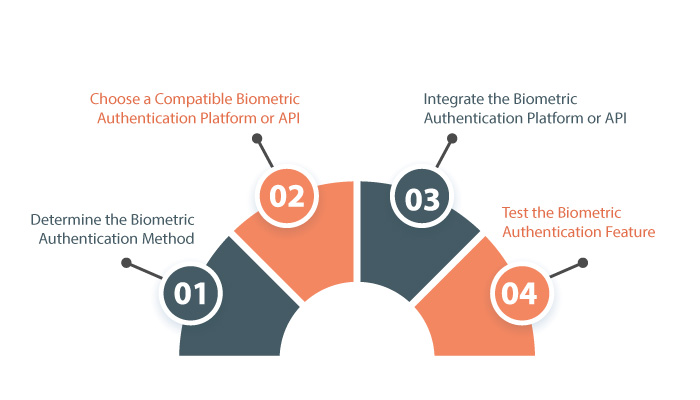Biometric authentication. This is the buzz word when it comes to mobile phones and mobile app security.
In fact, this is not a new concept, majority of us who use mobile phone are already familiar with one or the other form of biometric authentication methods.
Moreover, the technology is larger than ever. Statista suggests that biometric technologies will reach $55.42 billion by 2027.
But why, what’s so great about these technologies. Well, for starters, more than 56% users have seen reduced calls from call centre following use of biometrics Fingerprint recognition market.
Furthermore, more than 80% of active smartphones in North America, Western Europe, and the Asia Pacific have one or other kind of bio-authentication.
These numbers make you think, “Isn’t biometric authentication great? Should my app have it?” Well, that’s what this blog is all about.
What is Biometric Authentication?
Important question first, what is biometric authentication exactly?
Biometric authentication is the process of verifying an individual’s identity through their unique physical or behavioural traits.
In layman’s terms, it is when you verify your identity on mobile device via physical means, it’s called biometric authentication.Now, it is not something we are unfamiliar with. You see, bio authentication methods are being used in mobile devices for more than a decade now.
In fact, majority of the smartphones today, whether it is android or iOS ones, have some sort for biometric authenticator features. For instance, fingerprint, TouchID, face ID, and so on.
Not only in smartphones, but it is also seen in app development solutions. Speaking of which, this brings us to the different types of biometric authentication methods. Well, let’s discuss just that in detail in the platform below.
Types of Biometric Authentication in Smartphones

There are different types of biometric authentication. Based on the smartphones, the sensors it have, and the platform overall, authentication methods may vary.
So, what are these different biometric authentication app technologies? Let’s discuss the major ones down below:
· Fingerprint recognition
Truth be told, fingerprint authentication or what Apple calls “TouchID” is the most common type of mobile app biometric authentication.
As we all already know, it involves scanning the user’s fingerprint and comparing it to a pre-registered fingerprint to grant access. There are many benefits of this particular as it is very reliable. Let’s look at pros and cons of the same.
Pros
- Fingerprint recognition provides a high level of security, as each person’s fingerprints are unique and cannot be easily duplicated.
- It offers convenience, as individuals do not need to remember passwords or carry keys with them.
- It is a fast and accurate method of authentication, making it ideal for use in high-traffic areas such as airports, offices, and government buildings.
- Fingerprint recognition can be easily integrated into various devices, including smartphones, laptops, and tablets.
Cons
- Fingerprint recognition may not be suitable for individuals with certain skin conditions or injuries that affect the quality of their fingerprints.
- It can be expensive to implement, particularly in large organizations.
- There are privacy concerns associated with the collection and storage of biometric data.
- In rare cases, false positives or false negatives may occur, which can result in security breaches or inconvenience for users.
· Facial recognition
While this is not the most common, this is certainly close to it. This type of authentication uses a smartphone’s front-facing camera to scan the user’s face and match it to a pre-registered image to grant access.
As the time progresses and smart phones are getting smarter, a lot of smartphones companies are using it in their phone.
The primary example and probably the best ones too is Apple’s face ID. While most of the devices uses phone’s front camera, iPhones use dedicated sensors to gain precision. And the effect of this is often seen in a lot of iPhone app development solutions.
Pros
- Non-intrusive, no physical contact required
- Widely available technology, can be implemented in various devices
- Can work with a large number of people at once, making it useful for security and surveillance
Cons
- Accuracy can be affected by lighting conditions, facial hair, and other factors
- Can have difficulty recognizing individuals with darker skin tones
- Privacy concerns regarding data collection and storage
· Iris recognition
Well, this is a rather unique method of biometric authentication. And it uses your iris. You heard it right, and no, it’s not something unheard of. In fact, galaxy smartphone line-up by Samsung actually had this line-up.
What actually happens here is, this biometric authentication uses a smartphone’s front-facing camera to scan the user’s iris and match it to a pre-registered image to grant access.
Pros
- High level of accuracy, less affected by environmental factors
- Contactless, non-intrusive
- Difficult to spoof or imitate, providing strong security measures
Cons
- Requires specialized hardware and software
- Can be affected by eye conditions, such as cataracts
- Not suitable for individuals wearing glasses or contact lenses
· Voice recognition
Well, we don’t often see this type of bio authentication in smartphones.
While it’s working is quite simple. Voice biometric authentication uses a smartphone’s microphone to record the user’s voice and compare it to a pre-registered voiceprint to grant access.
And with this said, let’s look at some pros and cons of the same. These are, as mentioned below:
Pros
- Non-intrusive, no physical contact required
- Can be implemented on various devices, including smartphones and smart speakers
- Can be used as a secondary form of authentication
Cons
- Accuracy can be affected by background noise and speech patterns
- Can be impersonated using audio recordings
- Not suitable for individuals with speech impairments or accents that differ from the model used for recognition
How Does Biometric Authentication Work?
So, how does biometric authentication actually work?
Well, the biometric authentication technology systems capture, store, and match biometric data with the pre-existing data to authenticate a person’s identity.
The process of biometric authentication involves three phases:
- Enrollment: In this phase, an individual’s biometric data is recorded and stored. This data is then used as a baseline for future authentication.
- Authentication: In this phase, an individual’s biometric data is captured and compared to the stored data to verify their identity.
- Decision: In this phase, the system either grants or denies access based on the results of the authentication phase.
Moving on, biometric authentication is becoming increasingly popular due to its convenience and security. It eliminates the need for passwords, which are often forgotten or stolen, and provides a more secure authentication method.
Moreover, biometric authentication systems are not foolproof and can be vulnerable to attacks, such as spoofing or replay attacks.Overall, biometric authentication is a promising technology that offers a secure and convenient way to authenticate individuals.
With on-going advancements in technology, it is likely to become even more accurate and reliable in the future. And with this out of the way, let’s finally look at why your app needs biometric authentication.
Why Your App Needs Biometric Authentication?

Should you consider mobile app bio authentication? Absolutely, you should. And there are plenty of reasons to convince you to do so. Let’s see what these are. Here’s why:
· Enhanced Security With Biometrics Authentication
The very first reason to consider this is, bio authentication is one of the most secure ways to protect user information.
While passwords and PINs can easily be guessed or hacked, it is much more difficult to replicate someone’s biometric data.Moreover, this means that biometric authentication offers enhanced security for your app users, which can lead to increased trust and customer loyalty.
· User Convenience & Improved UX
Second reason to invest in bio authentication app is, it saves users the hassle of having to remember complex passwords or PINs.
This makes it easier for users to access your app, which can lead to increased usage and engagement.By removing the need for users to remember passwords, you can create a more seamless and enjoyable user experience.
· Increased Trust
When users know that their information is being protected by bio authentication, they are more likely to trust your app. Moreover, This can lead to increased customer loyalty and positive reviews.
In today’s digital world, where data breaches and identity theft are becoming increasingly common, users are looking for ways to protect their personal information. By offering biometric authentication, you can show your users that you take their security seriously.
· Competitive Advantage
This is still a relatively new technology, and many apps have not yet implemented it. By adding biometric authentication to your app, you can gain a competitive advantage over other apps in your industry.
This can help you to attract more users and grow your business.
Biometric Authentication in Fintech, An Essential
Fintech apps are all over the market, as billions of people around the world use and absolutely love them.
And you can’t actually close a conversation about biometric security without mentioning fintech apps. Reason being that this industry is the most avid user of biometric authentication technology.
Reason being that, mobile banking app with biometric authentication is what people want. And it applies across the spectrum including eWallet app development, loan lending, and the whole bunch.
So, if you are developing a fintech app, it is something you should consider. And with this said, let’s move to the next section.
How To Create Mobile App Biometric Authentication or Integrate It In Existing App?

Know that you know why you should do it, the next question is “how”. How do you create biometric authentication mobile application or integrate it in an existing one?
Well, it’s a simple process. And you actually might need to hire m obile app developers for it. In any case, the process is, as mentioned below:
1. Determine the Biometric Authentication Method
When implementing biometric authentication into your mobile app, it is important to determine which method to use.
While fingerprint recognition is the most common method, other options such as facial recognition or iris scanning may be more appropriate depending on the use case.
Moreover, consider the use case and the target audience to choose the method that would work the best.
2. Choose a Compatible Biometric Authentication Platform or API
Choosing a biometric authentication platform or API that is compatible with your mobile app development platform is crucial.
There are many options available, each with its own strengths and weaknesses, so it is important to do your research and select the one that best fits your needs. Make sure to pick a platform that is easy to integrate with your mobile app.
3. Integrate the Biometric Authentication Platform or API
Integrating the biometric authentication platform or API into fintech app can involve some technical work.
But most platforms and APIs provide detailed documentation and support to make the process as smooth as possible.Follow the instructions provided by the platform or API to integrate the biometric authentication feature seamlessly into your mobile app.
4. Test the Biometric Authentication Feature
Test the biometric authentication feature thoroughly to ensure it is working properly. This includes testing for accuracy, speed, and ease of use, as well as making sure it is compatible with different devices and operating systems.
Moreover, make sure to test the feature with different users to find out how well it performs for different use cases.
Bottom Line
This is all you need to know about biometric authentication. Now, most of the times when someone speaks of this security technology, it’s usually when they are developing fintech apps. So, if this is the case, you should definitely consider consulting top fintech app development companies.
FAQ
Mobile devices are becoming more integrated into our daily lives and contain sensitive personal and financial information. Biometric authentication provides an additional layer of security to protect this information from unauthorized access.
While no security measure is foolproof, biometric authentication is generally considered to be more secure than traditional password authentication. Biometric characteristics are unique to each individual and difficult to replicate.
Biometric authentication can be more expensive to implement than traditional password authentication. There are also concerns about privacy and the storage of biometric data.

Niketan Sharma is the CTO of Nimble AppGenie, a prominent website and mobile app development company in the USA that is delivering excellence with a commitment to boosting business growth & maximizing customer satisfaction. He is a highly motivated individual who helps SMEs and startups grow in this dynamic market with the latest technology and innovation.
Table of Contents












No Comments
Comments are closed.